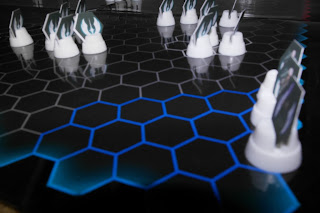Game Studies Post-mortem
For this project we were asked to generate a team brief describing the
tasks that we must undertake in the design of our board game. This brief had to
be calculated so that the workload reflected the time constraints of the
project and could be referred to throughout the project for reference. Our team
brief asked for the creation of a board game that conformed to the theme and
style of the Star Wars Battle Front IP, through the use of industry standard
design software. After some research we decided as a team to go in the
direction of a war game, similar to that of Risk or Game of Thrones but with
elements from board games such as Chess.
We started the task
by producing a series of sketches for the layout of the game board and some
general annotations about how the ideas would work. Once our individual ideas
were complete, we then joined together and deliberated over the ideas we had
come up with. Deciding on the best idea and how we could incorporate some of
the other ideas into this. Using this method of communication made everything
fair between the members of the team because every person had their own input
with regards to the mechanics of the game. Once this process was complete we
had a clear idea of what the end result should look like but more precise rules
and mechanics such as units attack and defence was yet to be decided. These
were much more intricate questions that needed to be answered through trial and
error when testing the playability of the game.
Our second task was
to delegate jobs so that every member of the team had a relatively equal
workload. A game board needed to be designed as well as the packaging to
contain it. The components for the board game also needed to be designed such
as the cards, unit counters and buff tokens. Once all of these items had been
designed and built, a rule book needed to be written and designed. Each of the
members of the team conveyed their strengths and weaknesses in an attempt to
ascertain which person was best for which job. Once everyone was happy with their
allocated jobs we then all set to work individually.
My individual tasks
were to design the packaging for the board game and build said packaging. To
start this task I took a trip to Toys ‘r’ Us In order to gain a better idea of
what is displayed on the packaging for board games. Once I had a clear idea of
what my design should include I then set to work on my design. Adobe Photoshop
was used to complete the packaging design. I was able to complete measurement
calculations, build a box net template and create illustrations for display on
the packaging design. Upon reflection it may have been easier to create the
illustrations using Adobe Photoshop but complete the packaging design using
Adobe Illustrator, importing the images created using Photoshop.
Building the package
design presented me with some problems, as I wanted the finished product to
meet a professional standard, or as close to professional as possible at least.
I thought hard about which materials to use and how the process should be carried
out. Once all of the variables were taken into consideration I began the build
process. Compressed cardboard demonstrated the correct properties that I had
seen in my research, allowing for a sturdy and durable construction that would
last through multiple uses. I did not have access to the professional printing
capabilities needed to print onto the card. This left me with the option of
combining a light weight stock print and the compressed cardboard, I used spray
mount to complete this task. Knowing that spray mount is a flexible adhesive
made me realise that I could not use it to fix the box together. Super glue was
the only substance that I could think of that would stand the test of time and
hold the packaging together through multiple uses. Once the packaging was build
I realised that more care needed to be taken during the measurement
calculations in order for the product to fit securely inside the packaging,
this meant that the packaging was a fraction too small for the product. If I
was to attempt this task again I would not make this same mistake and the
problem would be corrected early in the design process.
As deadline loomed
over us the communication between the team seemed to diminish. I believe this
was because the other team members had work to complete for other modules.
Taking this into consideration I tried to compensate by completing as many
tasks for the board game design as possible. This involved finalising any token
designs, printing any outstanding work and building the game board. At all
times during this period I was communicating with the team to resolve any
problems that I came across and to make sure that each member’s ideas remained
intact within the design. Unfortunately I could not complete checks on every
element of the design due to time constrains and the workload that I was faced
with. For this reason the rule book for the board game was not checked prior to
game testing deadline.
In
conclusion I believe that this project went well in the terms that a playable
and near professional standard board game was produced. Communication issues
between the team towards the end of the project presented a problem but most of
the issues were overcome, with each member of the team contributing useful
information in the completion of the build process. With a little more
communication we may have been able to iron out any issues in regards to the
information that was presented in the rulebook.










No comments:
Post a Comment